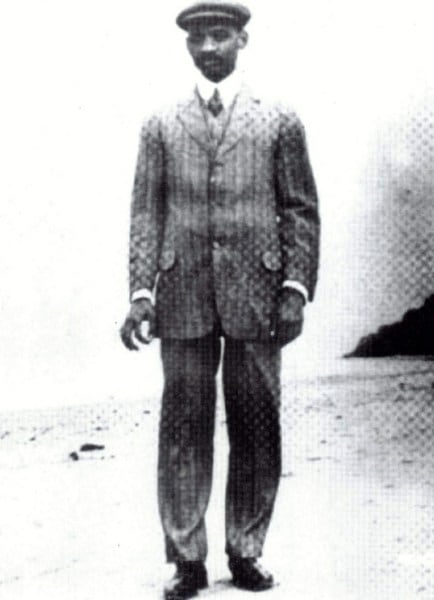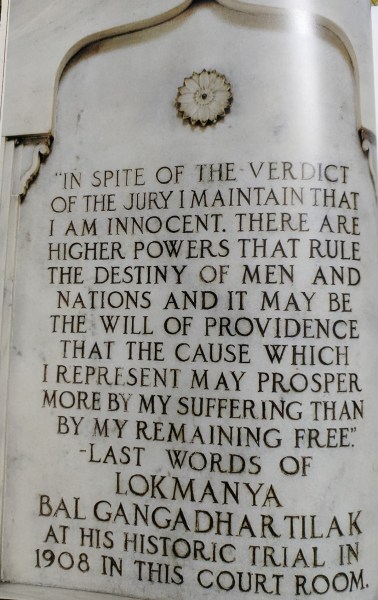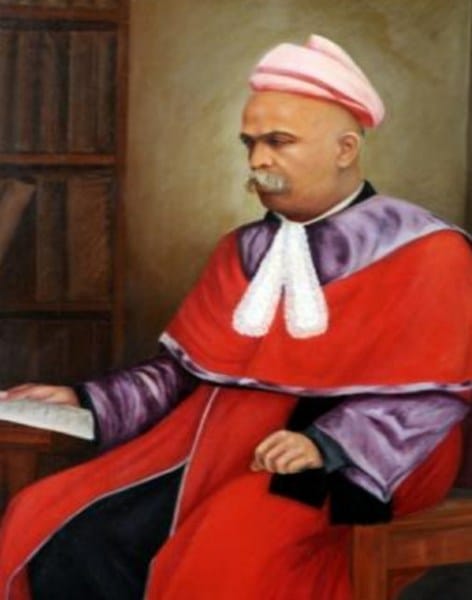As the country celebrates the 76th year of Indian Independence, the historical 160-year-old Bombay High Court stands tall in the nationalist movement with its strong association with prominent freedom fighters. It is from this court where most of them began their legal career before they took a plunge into politics while some were tried in the court in cases that had an impact on India’s freedom movement.
The roll call is both impressive and inspiring – Mahatma Gandhi, Dr. Babasaheb Ambedkar, Lokmanya Tilak, Sardar Vallabhbhai Patel, Vitthalbhai Patel, Bhulabhai Desai, K M Munshi, Justice M G Ranade, Justice Badruddin Tyabji, Pherozshah Mehta among many others. Their enrolment certificates, plaques, and portraits tracing back to their stints before coming to the High Court are an integral part of the majestic building. Maharashtra Tourism Department conducts heritage walks through the building on non-working weekends. Courtroom number 46, known as Central Court in which the Chief Justice of Bombay High Court currently sits, houses portraits of Gandhiji, Tilak and Ambedkar.
On returning to India after his higher studies, Dr Bhimrao Ramji Ambedkar started his law practice at the Bombay High Court in July 1923. Senior advocate Avinash J Rana in his book The Bombay High Court: A chronicle of judges and lawyers’ writes, “Ambedkar did not have a large practice (in HC)… But there is no gainsaying that he was a man of immense scholarship, the range of his reading and knowledge was not confined to the law and included history, sociology and economics…”
“..At one stage, owing to his learning and status in public life, there was a possibility of Ambedkar being appointed a judge of the High Court,” says P B Vachha, in his book Famous Judges, Lawyers and Cases of Bombay (A Judicial History of Bombay during the British Period).
Subscriber Only Stories
Ambedkar argued several cases as a lawyer before various courts. One of them includes the 1926 Keshavrao Jedhe-Dinkarrao Javalkar case, wherein Javalkar, belonging to the Non-brahmin movement in the state, had authored a book called Deshache Dushman (Enemies of the Country), which criticised Tilak and Vishnushatri Chiplunkar for their views on non-brahmin communities. Jedhe was a publisher of the book. The trial court convicted the duo, after which Ambedkar represented them in appeal arguing that Tilak and Chiplunkar were not alive and the third party cannot file defamation cases. This was accepted by the judge and set Jedhe and Javalkar free.
Among other cases, Ambedkar, in 1933 defended social reformist Raghunath Dhondo Karve, who was charged with obscenity for publishing certain content in a magazine called Samaj Swasthya to create awareness about sexual health, birth control, among others.
Ambedkar became the Principal of the Government Law College in 1935 and was later elected to the Constituent Assembly and became the chairman of the Drafting Committee and also became the first Law Minister of independent India.
Advertisement
Mohandas Karamchand Gandhi, known as Mahatma Gandhi, came back from England after becoming a barrister and immediately applied to the Bombay High Court on November 16, 1891. He practised for a short time in Mumbai Small Cause Court and went to Rajkot to practice. In 1922, he was sentenced to six years in prison for sedition based on his writings and was later released in 1924 due to medical reasons. After the sentence, his name was removed from the Roll of Inner Temple, London, and immediately, the then Bombay government placed the Inner Temple order before the Bombay High Court. Subsequently, his name was deleted as an advocate of the High Court on January 17, 1923.
Mahatma Gandhi (Bombay High Court Archives)
Kanaiyalal Maneklal Munshi, who became the Union Minister and Governor of Uttar Pradesh in Independent India, had practised before the High Court from 1913 and joined the chamber of Bhulabhai Desai, another proponent of Indian freedom. As per the High Court archives, Munshi was in close association with Tilak, Annie Besant, Mahatma Gandhi, Jawaharlal Nehru, Muhammad Ali Jinnah, and Sardar Patel. Munshi was a member of the Constituent Assembly, which framed the Constitution and later became a founding member of Vishwa Hindu Parishad (VHP). Desai, who acted as the Advocate General in 1926 for a short time, later defended accused military officers in Indian National Army (INA) trial in 1945-46 towards the end of the Second World War.
Sardar Vallabhbhai Patel, after he returned to India from England, applied to the Bombay High Court on February 14, 1913 and was enrolled the next day. He, however, did not practice in Bombay but successfully practised at Barsod, Gujarat. Within a few years, he entered active politics in 1917 and was one of the leading freedom fighters and also responsible for integrating native states into the Union of India as the first Home Minister of the country. His elder brother Vitthalbhai Patel, who was the co-founder of ‘Swaraj Party’ had long practice at the Bombay High Court since July 1908.
Advertisement
 Sardar Vallabhbhai Patel (Bombay High Court Archives)
Sardar Vallabhbhai Patel (Bombay High Court Archives)
“In spite of the verdict of the jury I maintain that I am innocent. There are higher powers that rule the destinies of men and nations and it may be the will of providence that the cause which I represent may prosper more by my suffering than by my remaining free.” These are words of Lokmanya Bal Gangadhar Tilak, which are engraved on a marble commemorative plaque outside the Central Court on the second floor of the HC building. The declaration came as the last words of Tilak, one of the prominent leaders of India’s fight for freedom at his historic trial in 1908 in the Central Court. After finding him guilty, an Indian judge sentenced Tilak to six years of transportation to Mandalay, Burma, and fined him Rs 1000. Tilak faced three sedition trials in the Bombay High Court.
 Lokmanya Bal Gangadhar Tilak (Bombay High Court Archives)
Lokmanya Bal Gangadhar Tilak (Bombay High Court Archives)
In 1897, he was charged with sedition for writing articles and speeches and the British government had alleged that the killings of its two officers, including Collector W C Rand, who was responsible for plague measures in Poona (now Pune) were due to Tilak’s incitement. Tilak was initially granted bail by the High Court and was later found guilty by the jury, sentencing him to 18-month imprisonment. Interestingly, the judge who announced Tilak’s sentence in the second trial, Justice Dinshaw D Davar, had represented him in his first trial in 1897.
 Words of Lokmanya Bal Gangadhar Tilak which are engraved on a marble commemorative plaque outside the Central Court on the second floor of the HC building. (Bombay High Court Archives)
Words of Lokmanya Bal Gangadhar Tilak which are engraved on a marble commemorative plaque outside the Central Court on the second floor of the HC building. (Bombay High Court Archives)
In 1916, Tilak was prosecuted for the third time on the charges of sedition, when he was represented for the second time by the then renowned lawyer Mohammed Ali Jinnah, who was convinced that Tilak had been prosecuted for his strong views about Home Rule and independence for India and defended him, which led to Tilak’s acquittal by the High Court and was ordered to furnish a bond of Rs 20, 000 of “good behaviour.”
Mahadeo Govind Ranade was Tilak’s senior in Congress from Pune. After completing his LL.B in 1866, Ranade enrolled as an advocate of the High Court around 1870. However, he never practised as an advocate and immediately joined the judicial services and served as magistrate and judge of small causes, before he was elevated as High Court judge in 1892.
 Mahadeo Govind Ranade (Bombay High Court Archives)
Mahadeo Govind Ranade (Bombay High Court Archives)
Owing to his constant run-ins with the then British government due to his political and social work, his promotion was delayed. He founded the Widow Remarriage Association in 1866 and was one of the founders of the Indian National Congress (INC), in 1885. In 1887, Ranade founded National Social Conference, INC’s social reform cell that discussed and deliberated resolutions passed, including those about marriage age, ill-assorted marriages, polygamy, caste marriages, female education, and so on.
Advertisement
“Ranade, besides being a very able and erudite judge, was also a great scholar and made outstanding contributions to Indian history, particularly the history of Maharashtra and also the history of Marathi literature,” Vachha writes.
In a largely attended public meeting in then Bombay to mourn Ranade’s death in 1901, his colleague
Advertisement
 Justice Badruddin Tyabji (Bombay High Court Archives)
Justice Badruddin Tyabji (Bombay High Court Archives)
was present. Tyabji, who returned to India in 1867, was the first Indian barrister to practice in the Bombay High Court in its Original jurisdiction and its first Indian barrister judge (which before his time was exclusively in the hands of English barristers). He was elevated to a judge in 1895. “He made a strong, hard-headed and independent judge, ” P B Vachha notes.
“Before he was raised to the bench, Tyabji was very well known in public life for the active part he took in all contemporary movements, political, civic, social, and educational, particularly Muslim education, in promoting which he spared no time. He had the distinction of being the first Muslim President of the Indian National Congress (in 1887),” Vachha adds.
Advertisement
In 1902, he became the first Indian to hold the post of Acting Chief Justice of the Bombay High Court. Tyabji, who was considered among the moderate Muslims in the Indian freedom movement, worked to weaken the Zenana system and campaigned against the ‘purdah’ system.
In 1885, he founded the Bombay Presidency Association with K T Telang and Pherozeshah Mehta. “The great triumvirate of Kashinath Trimbak Telang (HC judge), Sir Pherozeshah Mehta ( HC advocate), and Badruddin Tyabji – a Hindu, a Parsi, and a Muslim – each a leader of his own community, each intellectually brilliant, each a first-class public speaker and fired by Indian nationalism, where caste, creed, and religion had no place whatsoever,” Senior advocate Iqbal Chagla writes in a chapter called ‘The renaissance men in robes’ in a book Heritage of Judging: The Bombay High Court through one hundred and fifty years.
While the country celebrated the ‘Har Ghar Tiranga’ campaign on Independence Day, the Bombay High Court on the stroke of midnight on August 15, 1947, had witnessed a one-of-a-kind event, where HC’s last British Chief Justice Sir Leonard Stone unfurled and saluted the Indian National flag inside the Central Court and also a larger flag was hoisted on the premises thereafter. Stone continued as the Chief Justice for another year before Justice Mahommedali Currim Chagla took over as first Indian Chief Justice of the Bombay High Court in 1948.
Source: https://indianexpress.com/article/cities/mumbai/advocates-of-indian-independence-and-the-bombay-high-court-8094246/


